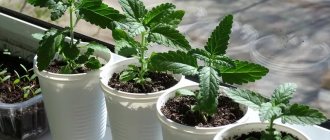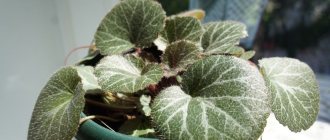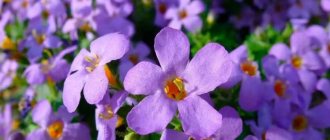Amazing, fragrant and unpretentious heather can create a unique landscape design for a country house, with difficult climatic conditions. However, to preserve its health, beauty and aroma, the gardener should study the features of planting, care, fertilization and propagation, as well as learn how to deal with pests and diseases that can affect heather.
Modest and unpretentious, heather is the only plant that agrees to grow on the bare, windswept slopes of the Scottish hills. So says the old legend. For this, God rewarded him with special charm and amazing aroma. Let's create a real heather paradise in our garden!
In nature, there is only one species. A species is an evolutionarily formed set of individuals, characterized by a single... heather - common heather. In strict accordance with the Scottish legend, it inhabits territories with the most difficult soil and climatic conditions: mountainous terrain and marshy heaths, peat bogs and tundra plains. Under natural conditions, it can be found in Northern and Western Europe, Asia Minor, North Africa and here in Siberia. Heather grows slowly - only 2 cm per year. But it lives a long time - up to half a century!
From the natural appearance of heather, through the efforts of breeders, many magnificent varieties have been bred, differing in flowering time. Plants bloom from mid-June to late autumn, until they are covered with snow. The picture of flowering heathers is reminiscent of an ancient tapestry! Modest goblet-shaped flowers impress with a variety of shades - from white and soft pink to bright crimson and lilac-purple. The leaves also vary in color - green, silver, yellow-bronze, orange-red! By combining different varieties of heather, you can create a charming heather corner in your garden and prolong the flowering of your garden for a long time.
Heather is an excellent honey plant and attracts many bees and bumblebees to the garden. Its subtle aroma is amazing, and heather honey has healing properties! Heather flowers and twigs are added to vitamin tea and used to enrich the taste and color of tinctures, homemade wines and liqueurs.
When can you plant common seasonal heather in open ground in different regions?
Russia extends over 3 climatic zones, so the temperature regime in the regions is different. This affects the duration of the summer season as a whole, and directly on the planting of perennial plants.
In outskirts of Moscow
Heather is sold in nurseries and stores all year round, but this does not mean that planting is also possible at any time. The most favorable time for planting: late April or September. This way the plant will not be damaged by frost and will be able to take root. An important rule: do not buy seedlings in advance. At home, the plant wakes up and begins to actively grow leaves. Heather does not like transplanting.
In Siberia
Planting heather in Siberia is recommended in the spring. It is best to carry out field work in May. Then the plant will have time to take root and grow without the risk of damage to the root system. Landing is allowed in early September. The air temperature this month remains stable, which has a beneficial effect on foreign varieties that do not like temperature changes. But there is a risk that the plant will not have time to take root before the onset of frost.
In the Urals
Although wild heather shrubs are common in the flora of the Urals, planting an ornamental plant in open soil requires a special approach. If we are talking about foreign heat-loving varieties, then it is better to refuse planting in the garden.
It is recommended to plant seedlings in spring. Due to the harsh climate, planting shrubs in the fall is not recommended. As a last resort, you can do this in August.
How to properly plant heather in open ground at your summer cottage
To successfully plant heather, it is necessary to create conditions as similar as possible to those in which it reproduces in the natural environment. The climate of central Russia is most favorable for active plant growth. Acidic, loose soil is suitable for it. The alkaline and calcareous environment does not allow the shrub to take root properly. Consider this point when choosing a landing site.
Seedlings in the fall to overwinter
Planting heather in autumn is recommended exclusively for central Russia, where winter frosts are not too severe. Only here will it be possible to preserve an unrooted plant until spring. Otherwise, the immature root system will not withstand the cold and the plant will die, even if the young bush is covered and insulated.
If the height of the seedlings is less than 2 cm, planting in open soil in the fall is prohibited. In this case, place the seedlings in pots and keep them at home until spring.
in spring
Heather seedlings are planted in the spring after the soil has warmed up. Shrubs should not be planted immediately after frost. The roots of the plant will die because they will not be able to take root and receive enough nutrients.
In central Russia, plant the plant in late April - early May. If we are talking about more northern regions, landing is possible from mid-May. This will allow the heather to take root deep enough before the onset of cold weather, which will protect the bush from damage.
Useful tips
- If you plant heather in a constantly dry area (for example, under trees), it is guaranteed to survive any frost. However, it will be impossible to wait for flowering.
- The shrub grows and develops best on sandy and peat lands.
- Excess of any fertilizer causes wilting of the tops and browning of the leaves.
- Coniferous spruce branches are considered the best covering material for heather, as they help the development of beneficial fungi.
- Heather in a pot at home will live no more than one season, dying during the winter.
Features of planting
The correct planting of heather is influenced by many factors: from the type of plant to the place from which it was brought. Thus, a wild shrub is less demanding to environmental conditions, but is more difficult to transplant. Decorative is ready for planting, but is more demanding in care.
Store bought
To successfully plant heather, purchase high-quality seedlings. The plant has one peculiarity: the flowers remain beautiful for a long time after damage and death of the root system. Therefore, it is important to know what to look for when choosing a shrub seedling.
Criteria for selecting heather seedlings:
- The soil in the container is moderately moist. Too dry soil leads to depletion of the root system. If there is excessive moisture, the roots quickly begin to rot. This may not be noticeable upon inspection, especially if the container is opaque.
- When examining the container, you should not have the feeling that the plant has just been moved there. It should fit snugly to the base and roots. This will provide protection from excessive air intake and chapping.
- The seedling has old and young shoots. They differ in color.
- There are buds and young leaves on the shoots. They are elastic to the touch.
From the forest
It is difficult to transplant a plant from the forest. Its roots are intertwined with the mushrooms living there, so it is difficult for the shrub to take root in the garden. Create the most similar conditions in the garden, then the likelihood of survival will increase.
Rules for transplanting heather from the forest:
- When removing a plant from the soil in the forest, do not clear the roots from the soil. On the contrary, try to dig them up with a large ball of soil: about 2 times the size of the crown.
- Choose plants that have settled on a dry edge. Their root system is more compact, which reduces the risk of damage.
Conifers
- The main criterion in the selection of coniferous plants for a mixborder is compactness - wild spruce, pine, fir, arborvitae, spreading junipers and similar powerful plants are unacceptable.
- Fast-growing plants with a horizontal crown are very good: microbiota (Microbiota) and creeping junipers (Juniperus) - they can easily withstand shaping pruning, and it is not difficult to restrain their growth.
- The main ones should be slowly growing columnar and narrow pyramidal varieties of junipers and thujas, spherical and dwarf firs (Abies koreana “Piccolo”), spruce, mountain pines, yews, thujas.
- Cypress trees (Chamaecyparis) are especially valuable - their varieties are extremely diverse and are easily formed by pruning. Just keep in mind that not all cypress trees are winter-hardy in our region.
- In addition to plants with beautiful crowns, the mixborder should contain varieties with unusual colored needles - silver, golden and variegated.
- The variety of types of needles can also play an important role: scaly, awl-shaped and needle-shaped - even with similar colors, such plants differ in texture and create visual penumbra, which gives the composition additional volume.
- Using the endless variety of conifers, it is quite possible to create a composition only from them, but without including seasonally flowering plants it will be too ascetic, and therefore boring. That is why we cannot do without heathers and the unpretentious dwarf shrubs and flowering perennials that complement them.
Where to plant
Heather does not tolerate transplantation well, so choose a location and prepare favorable soil in advance. Typically the plant lives in one place for about 20 years. The shrub is not picky about temperature and environmental conditions. Due to properties such as hardiness and drought resistance, the natural habitat of heather is Africa, North America, moderately cold areas of Europe, and the Alpine mountains at an altitude of 2500 m.
In the shade or in the sun
The plant loves semi-shaded and sunny places, but constantly shaded areas will not do it any good. This is due to the natural conditions for the reproduction of heather. Beautiful flowers bloom on a shrub that grows in direct sunlight. The less sun, the less attractive the blooms.
Choose a place well protected from wind and excessive humidity. If there is a risk of flooding, install drainage.
What soil to plant heathers in and how to prepare the soil for planting yourself
Heather loves acidic soil, so an alkaline and calcareous environment is not suitable for it. In the wild, the plant is common in poor soils, peat bogs and pine forests. For good growth, it is best to create the most similar conditions for the plant.
Loose, breathable soil is recommended. The most favorable is considered to be coniferous soil with decomposed particles of spruce, pine forest, and peat. Add particles of bark and sawdust from coniferous trees, or acidic peat (Ph 4–5) to the soil.
If you choose a low location, be sure to install drainage in a ratio of 1:3 to the soil. Without it, the root system rots due to excess moisture. For drainage, use expanded clay, sand, fine gravel, broken brick. This promotes good flowering.
North Pole and other parts of the world
If a person could study the movement of the main luminary from the North Pole, he would see the rotation of the Earth counterclockwise, as well as the place where the sun sets and how it rises. Visually, the movement of the celestial body will appear as a move from east to west. In fact, it will move east, and the Earth will rotate around its axis.
Interestingly, in different parts of the world the sun does not rise at the same time. For example, on the East Coast of the United States this occurs another 3 hours before those areas that are on the Western coast. Accordingly, sunset in different parts of the world occurs at different times.
What plants can heather be planted with?
Heather gets along best with plants that love the same acidic soil. These are mainly low-growing shrubs (Thunberg barberry), herbs (Masus repens), flowers (grass carnation, Amur carnation, eight-petalled dryad), as well as small coniferous trees and ferns. In decorative design, landscapers in central Russia often use compositions of heather with azalea or rhododendron.
Heathers in landscape design.
Win-win flower garden design ideas
Low heathers are easy to combine with coniferous trees, and deciduous plants and a variety of flowers are also suitable. Heathers of different colors allow you to zone a beautiful garden, separating areas.
The following methods can be considered universal options for garden decor:
- Heathers and Erica can be supplemented with rhododendron bushes, which are planted along the fence, and heather is placed in front of it;
- It’s as easy as possible to combine multi-colored heathers with each other. To do this, you need to select several varieties of plants with different shades of leaves and inflorescences, plant each of them in a certain area, which may have a curly shape;
- Evergreens can be placed around the perimeter of the gazebo, flower beds with tall flowers, around the house;
- You can create a separate zone in the garden and plant Erica there, and place natural stones of different sizes around it, pour sand, imitating a mountainous area;
- Dry stumps, branches and curved roots in combination with heather look impressive in the garden;
- In a garden with many small hills, you can plant plants of different shades, each of which is located at a certain height;
- Planting plants along the paths will decorate the garden.
Tall trees on the site with dwarf bushes look unusual and are suitable for a small garden. Choose any color of vegetation, for example, pink and white will make the design light and delicate. Dry roots will be a good addition to fairy-tale decor.
At what distance should heather be planted from each other?
Heather does not like transplanting, so prepare the soil in advance. The area that the shrub will occupy depends on the variety chosen. To get your bearings, count on a distance between bushes of 20–60 cm. Thus, up to 10–15 small varieties of plants, and a maximum of 8 heather bushes of large species, can be placed per 1 sq. m.
Bush planting scheme.
If you plant the seedlings too densely, after 1–2 years the plants will be crowded. You will not be able to get a large beautiful crown. More sparse planting does not harm the heather. The plant reproduces actively and likes to survive other plants in the area. Therefore, monitor this process annually, otherwise only heather will remain in the garden.
Problems, diseases and pests of a flower
Resistant to pest attacks, heather can suffer from viral and fungal infections.
- The attack of viruses is manifested by unsightly bending of branches, incorrect colors of flowers and leaves, and inhibition of the development of the shrub. Such infections are easy to recognize and almost impossible to cure. The only measure involves the disposal of affected plants by burning them. This will help prevent the disease from spreading to other bushes.
- Heather is often attacked by gray and root rot fungi, which appear with constant dampness. If young branches suddenly begin to die, the shoots become covered with an unpleasant coating, and the leaves fall off en masse, it’s time to use fungicidal preparations to destroy pathogenic fungi. Fundazol, Rovral, Hom, Topaz will help against them.
ADVICE! Periodic spraying of bushes with copper preparations will prevent any attacks by pathogenic fungi that cause rot, rust and powdery mildew, from which heather is not at all immune.
When it blooms
Heather looks very beautiful during the flowering period. Up to 20 small flowers can be seen on racemose inflorescences. The color depends on the chosen variety. The most common varieties are purple and pale pink, but there may be others.
Heather flowering period: from July to mid-autumn. After flowering, the plant remains green and does not harm the garden design. If you live in a mild climate, the heather will live on its own. If you have a harsh winter, especially if there may be little snow, cover the bushes for the winter with spruce branches or any non-woven material to protect them from freezing of the roots.
Preparing for winter
In order for heather to survive even a severe winter, it should be prepared for the onset of frost. Pre-winter care consists of constructing a double shelter. Typically, heather insulation is carried out at the end of October or beginning of November, while the soil is not yet frozen.
First, the soil under each plant is well sprinkled with a layer of peat or some non-woven material to cover the plants (in extreme cases, dry leaves can be used). It is recommended to make the layer at least 10 cm. Then the bushes are covered with spruce branches. Around mid-April, the spruce branches are removed, and the root collars of each specimen are freed from peat.
How to take care of the garden
The key to a lush and blooming garden is proper care of plants, taking into account all the features that have developed during life in the wild. Heather is no exception. The shrub does not require constant attention. Next, I give basic recommendations for caring for heather.
What to feed
A healthy plant does not require additional feeding. Heather is used to living in harsh conditions, so it can obtain all the nutrients itself. If you see that the plant is lethargic, the leaves begin to turn pale, the color is sparse, then feeding is needed.
The bush is fertilized in late spring. Give preference to special additives. But if the store doesn’t have one, take the universal ones. Choose a fertilizer that does not contain calcium. It harms young plants. Fertilize the soil near the plant, not the bush itself. If the fertilizer is in the form of granules, be sure to water the heather well so that the beneficial substances go into the soil.
How to water
When caring for heather, remember the main rule: it is better to under-water than over-water. In the natural environment, the plant tolerates drought better. If your area has average temperatures and rains consistently, additional watering will not be needed.
The shrub needs to be watered only in hot, dry summers. Pour water so that it hits only the root, without touching the crown. Otherwise, rot may appear on the leaves in the form of a gray coating.
For hydration, use acidified water. To prevent moisture from evaporating excessively, the ground must be mulched. Loosen the soil at a distance of 10–15 cm from the bush after watering and remove weeds. This can be done through the mulch without removing it from the ground.
Diseases and pests
Heathers are rarely attacked by pests. Here are the most common ones:
| Gray rot | The most common disease of shrubs. Reason: high humidity, poor drainage and stagnant water. Most often it occurs due to improper watering and shelter for the winter, when the fungus multiplies on the crowns in warm, humid air. If you notice grayness on the leaves and shoots, dying shoots, falling leaves, use Fundazol or Topaz. In advanced cases, treatment with a 1% solution of copper sulfate is effective. If necessary, irrigate once a week. |
| Leaf necrosis | The death of the midrib of a leaf, when the upper part turns brown. Occurs when there are sudden changes in temperature, severe frosts, and lack of moisture and nutrients in the soil. |
| Sunburn | It appears as darkening of flowers on one side of the heather. To prevent problems, do not water or spray the plant during hot hours. |
| Late blight root rot | Manifested by the wilting of the plant. The roots begin to rot from the tips. Dig up the diseased plant with a clod of earth so that the disease does not spread to healthy bushes. Treatment with the following drugs is effective: Ridomil Gold, Fitosporin-M, Planriz. |
| Root cancer | The plant stops growing, the shoots turn yellow, and growths appear on the roots. |
| Mixed chlorosis | The first sign is yellow spots on the leaves. It occurs due to a lack of nutrients and oxygen in the soil. To get rid of the problem, you need to regularly feed the plant. |
Heather diseases.
Do I need to cover it for the winter?
Heathers do not tolerate winter well. In the absence of snow, the roots freeze and the plant dies. If the winter is snowy, a layer of snow covers the bush, and a crust of ice forms on top, which prevents the plant from breathing. Heather should always be prepared for winter.
- In a radius of 10–15 cm, mulch the plant with a thick layer of fallen leaves or peat.
- Cover the plant with spruce branches.
Such manipulations will help protect the bush from frost and wind, but at the same time provide access to air. The needles gradually fall off and rot, which further oxidizes the soil.
After the end of frost, remove the spruce branches and move the mulch away. If this is not done, the heather will bloom poorly.
Cuttings
Cuttings are one of the simplest and most effective methods. To reproduce, the plant must have young, but not flowering, shoots, so the most favorable time for the procedure is summer. Do not use flowering shoots for cuttings. They do not take root well and rarely grow into large shrubs. As a last resort, shoots that have already bloomed can be separated from summer-blooming heathers.
For planting, use a mixture of sifted peat and sand. If you don't separate out the large particles in the peat mixture, it will be difficult to separate the plants. Firm the soil in the container so that it does not reach 1 cm from the top edge.
If you want to propagate different varieties of heather, do not use one container for this. Each type of shrub has its own characteristics of the root system, so young plants harm each other.
Algorithm for planting cuttings:
- Cut vegetative shoots from the plant.
- Remove the lower leaves of the shoot. This will be the cutting for planting.
- Make holes half the length of the cutting and place it in the hole. Do not compact the soil after planting. Plant the cuttings 20mm apart.
- Water the heather with a fungicide solution.
- To speed up rooting, keep the container with cuttings in a warm room with high humidity. It is better to cover the vessel with glass or film.
- The first shoots appear after 2–4 weeks. After this, remove the glass and harden the cuttings.
- To plant rooted cuttings, remove them from the container and carefully separate them. After this, plant the plants in separate pots.
- The plants will be ready for planting in open ground no earlier than in 2 years.
Algorithm for planting heather cuttings step by step.
Dividing the bush
This is the easiest way to propagate heather. At the end of August or autumn, dig up a bush with a large lump of earth so as not to damage the root system. After this, it is necessary to remove all faded buds and tall shoots. There should be some low stumps left.
Now the plant is ready for propagation by dividing the rhizomes. Carefully divide the bush into several parts. Plant new plants in pre-prepared holes. Don't forget to water the heathers well to help them take root faster. Mulch the bushes and prepare them for winter.
In the spring you will see young shoots. This means the heather is rooted and ready to grow.
By layering
This method is used in the spring. To propagate, select a healthy plant and separate a strong branch from it (but do not cut it). Remove all the leaves and bend it to the ground. Use wire to secure the branch in the hole.
Secure the part of the branch that remains outside to the base. Water the plant regularly with warm water. In autumn, the plant is ready to separate from the mother. Now carefully cut the branch from the bush.
Next year, plant the young plant in a new location as needed.
Heather propagation by layering.
Seeds
Propagation of heather by seeds is a labor-intensive and lengthy process. To obtain seedlings it will take 2 years. To successfully grow heather, you need to prepare the seeds for planting:
- Place the seeds in a 2 mm layer in a glass.
- Add a little water to moisten all the seeds.
- Cover with film.
- Wait 2-3 weeks for the seed to germinate.
- Open the film and leave it for a few days to harden.
When the seeds are ready, plant them in large containers in special soil. Air temperature 18–20 degrees. You need to wait about a month before germination. Do not forget to monitor the moderation of humidity in the room and in the soil. In the warm season, periodically take the seedlings outside to harden the seedlings.
Seedlings
If you grow seedlings from seeds yourself, it will take you more than 2 years. Seedlings should be periodically taken out into the open air, and should not be allowed to stay in temperatures below 10–12 degrees.
It is much easier to grow heather from seedlings purchased from a nursery. After purchasing, immediately plant the seedlings in pre-prepared soil at a distance of 20–60 cm from each other, depending on the variety. Compact and mulch the soil after planting. If the soil in the area is clayey, install drainage.
Features of planting popular species and varieties
The general rules for planting heather are the same, but due to the characteristics of some varieties, nuances may arise. Keep in mind that ornamental species are more delicate and therefore require more care than their forest relatives.
Alba Plena
Heather is distinguished by small white flowers and low shoots that grow tall. It grows slowly, so planting can be more dense.
Alexandra
Heather has low bushes with a purple color and dark green leaves. The variety is distinguished by its spherical shape.
Alicia
The plant is distinguished by large white flowers on bushes up to 20 cm high. It blooms in the first half of summer. Not picky about soil, grows slowly. Plant Alicia 20-25cm apart.
Allegro
The plant prefers sunny, open areas and grows up to 60 cm in height, so plant seedlings at a great distance (about 100 cm) in holes 40 cm deep. The variety does not tolerate cold well and can die from the first frost, so prepare it for winter in advance. Allegro is resistant to pests and diseases.
Boscoop
Heather is characterized by bushes up to 35 cm tall with lilac-pink flowers. It blooms from August to September and tolerates drought and prolonged heat.
Hamilton (JH Hamilton)
The plant has a rounded shape, about 30 cm high. Sometimes bushes up to 60 cm are found. The flowers are collected in light purple inflorescences. Hamilton blooms from July to September. This heather needs to be watered only during prolonged dry heat.
Garden Girls
Bright pink flowers grow on a crown 20 cm high. It blooms in late summer until frost. It tolerates winter well; in the conditions of central Russia, it most often does not need winter insulation. It does not tolerate moisture well, so it is best to install drainage when planting.
Gold Haze
The variety is distinguished by large snow-white bell-shaped flowers. The leaves are bright lemon color. The plant reaches a height of 60 cm, so the required distance between bushes is 50–100 cm.
Dark Beauty
The variety is distinguished by light red flowers. Crown diameter up to 40 cm. The plant does not tolerate moisture well, so it requires drainage when planted in low areas. The shrub blooms until the end of November. It has a large root system and does not tolerate dense planting.
Calluna Beauty Ladies
The bushes grow up to 40 cm high and have lilac flowers. It is recommended to plant up to 8 pieces per 1 square meter. m.
Carmen
This is a variety of heather with a wide but compact crown up to 40 cm high. The color of the flowers is pink-violet. Does not tolerate frost well.
Marlies
The plant reaches 30 cm in height, the crown width is approximately 50 cm. Therefore, the recommended distance between plants is about 100 cm. It is distinguished by pink or purple flowers.
Silver Knight
The variety was bred in England. The crown is approximately 40 cm in diameter and up to 30 cm in height. The bark is gray-silver or brown, the flowers are lilac and lavender. The plant is resistant to cold, but in harsh climates it needs to be covered.
Spring Cream
The shrub pleases the eye with snow-white flowers. Undemanding in care, tolerates both heat and frost. Blooms from August to October. Crown height up to 35 cm.
Firefly
An adult plant reaches a height of 40 cm. Heather tolerates frost well and belongs to frost resistance class 4. The color is pink-violet, blooms from August to October.
Botanical description
The heather plant is a strongly branching, creeping evergreen shrub from 30 to 70 cm high with small triangular leaves, as if rolled into a tube, and small, fragrant, bell-like pink-purple flowers collected in one-sided brushes. Heather blooms in mid-summer, and reaches the peak of its beauty after the first frost, when its leaves acquire yellow and burgundy shades.
Heather was glorified in Robert Louis Stevenson's ballad “Heather Honey,” which we have known since childhood. And let someone think that the story described in poetry is fiction, but the fact that heather is an excellent honey plant, and the honey from it surpasses any other honey in healing qualities, is the true truth. Landscape designers prefer to plant heather along garden paths, on alpine hills, in borders, against the backdrop of dwarf conifers.
- Irises in the garden
Gardener mistakes
Although heather is an unpretentious plant that is resistant to different weather conditions, not everyone can grow heather in their garden. Most often this happens due to mistakes that gardeners make when planting and caring for shrubs.
The main mistakes when growing heather:
- Planting in ordinary garden soil. An alkaline environment is not suitable for heathers, no matter how carefully you care for them. It is necessary to prepare the soil for planting: bring in peat, bark, spruce, and oxidize the soil.
- Planting shrubs in the shady part of the garden. A beautiful lush crown can only be obtained from a plant located in the sun or partial shade.
- You notice that the plant lacks nutrients, but do not apply oxidative fertilizer.
- Too frequent watering or prolonged lack of moisture. In the case of heathers, it is better to underwater than overwater to prevent stagnation of moisture in the soil. But nevertheless, during prolonged drought, which is accompanied by high temperatures, it is necessary to water the bushes.
- Planting heather at the wrong depth. If the roots are not placed sufficiently or too deeply, the heather does not grow well.
Introduction
The plant gave its name to the first autumn month, which among the Slavic peoples is called “Veresen”. Heather is an excellent honey plant from which bees collect the last pollen of the year. Heather honey is not just a beautiful legend, sung by Robert Stevenson in the poem of the same name, it is a wonderful reality.
Modern landscapes are decorated with more than 500 varieties, which are planted in separate gardens or rock gardens.
From a botanical point of view, the species Common Heather (Calunea vulgaris) is characterized as a semi-evergreen subshrub. Its shoots become woody partially in the lower part, and small leaves remain green only at the ends of the branches.
Like most representatives of the family of the same name, it is able to survive exclusively in close union with fungal mycelium. The plant extracts nutrients from poor soil thanks to fungal threads - hyphae.
Natural heather plantations are found in the northern part of the Eurasian continent
Under the stems of creeping plantings, a specific gray sandy soil is formed, in which nitrogen, phosphorus, potassium and other elements are virtually absent. Only thanks to beneficial microorganisms does the plant receive the necessary nutrition. The shrub will not grow in a personal plot if such microflora is absent.
Reviews from gardeners growing heather on their property
Maria, 53 years old
I bought Heather by accident. I just liked the look. I started reading at home about what to do with it, and realized that there would probably be another dried flower in the flowerbed. Everything seemed so complicated. But she dropped me off anyway. He survived a winter, then a drought, then another winter. Now I have already planted it and grown into half the garden. I also bought different types. Blooms from late June until winter. Beauty.
Mikhail, 48 years old
A few years ago we finally moved into our house and the question arose of improving the area. There is a problem. The soil is acidic. This narrowed our design options. My wife ordered various seedlings on the Internet, and we got to work. Everything was planted in the fall. There were trees and bushes there. I was worried about how they would survive the winter. Our frosts are severe. Everything took root. Even heathers. Even though I thought the frost would kill them, they were planted too late. 3 years have passed, there are already shoots. Blooms well. The wife is happy.
Ekaterina, 62 years old
I saw heathers at my neighbor's place. They bloom so beautifully. For six months. I asked for a few branches when she was seating them. I had to dig around a bit, it turns out that the soil there is not so easy, it needs to be oxidized. But fortunately, the stores now have everything. I don’t have a plantation yet, but everything is ahead. They don’t need anything except fertilizer now. This can be planted.
Use of heather
Heathers are famous not only for their appearance, but also for their beneficial properties. They have been used in agriculture and medicine since ancient times.
In old times
In botany, the plant is known as Calluna. The word comes from the ancient Greek “to sweep.” This is directly related to the basic function that people used many hundreds of years ago. Heather makes a strong broom.
The Irish and Scots used bushes in construction. Dry heather stems were mixed with clay and straw and used as building material. You've probably seen photographs of old huts completely covered with branches.
The hut, covered with branches, may well be partly made from dried heather.
The leaves of the bushes were collected and dried. This is an excellent filling for mattresses.
The shoots were used for weaving baskets. And dried heather in the mountainous areas was almost the only heating material.
In medicine
Due to its beneficial properties, heather has found use in folk medicine. Since ancient times, it has been used to prepare medicines for various diseases:
- as an antibiotic for urinary tract infections;
- with prostatitis;
- from urolithiasis;
- for snake and insect bites;
- as a diaphoretic;
- from problems with the gastrointestinal tract: colic, diarrhea, unpleasant painful sensations, gastritis, enterocolitis, dysentery;
- for skin diseases, burns and wounds;
- for inflammation of the oral cavity;
- to relieve symptoms of tuberculosis;
- against hair loss with local rubbing.
Today the plant is used in homeopathic medicine. It is used to get rid of toxins.
Research shows the effectiveness of heather extract in the treatment of rheumatoid diseases.
You may be interested in growing a knotweed flower in your garden, because it also has medicinal properties.
In landscape design
Heathers are often used in landscape design. A variety of colors, shapes and sizes allow you to decorate the garden of the most sophisticated connoisseur. The plant blooms for 3 to 6 months and combines well with other shrubs and flowers, allowing you to create a variety of compositions.
I often use heathers when creating alpine slides. They are used as ground cover plants, thanks to which weeds do not multiply.
Heather looks truly magnificent in landscape design.
The shrub attracts the attention of honey plants, therefore it is valued by beekeepers.
I also recommend decorating the garden with daisies, and how to make the right choice is described in the article “What perennial varieties of daisies to plant in the garden.”
conclusions
- Heather is a perennial plant that requires little care.
- It is better to plant heathers in spring.
- Be sure to oxidize the soil before planting.
- Heather does not like excessive humidity. If there is a risk of flooding, install drainage.
- Most varieties of heather need to be watered only during prolonged hot weather and drought.
- In central Russia, the shrub survives in winter without insulation, but it is still better to prepare it for wintering.
- Heather can be propagated by layering, seeds, seedlings, or dividing the bush.
- The plant is rarely susceptible to disease.
- Due to its beneficial properties, the plant is used in agriculture, medicine and landscape design.











